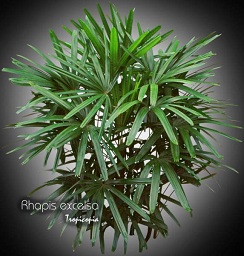Table of contents
Lady palm

Latin Name: Rhapis excelsa
Category: Palm
Family: Arecaceae
Origin: China
Climate: Subtropical
Growing Zones: 11, 9
Care Instructions
The Lady palm (Rhapis excelsa) is a subtropical plant that originates from China. This palm plant belongs to the Arecaceae family and is well-suited for growing in USDA zones 11, 9.
Complete Care Guide for Lady Palm (Rhapis excelsa)
Watering Requirements
The Lady Palm (Rhapis excelsa) thrives in consistently moist soil, but it is crucial to avoid overwatering, which can lead to root rot. Water the plant when the top inch of soil feels dry to the touch. During the growing season (spring and summer), the Lady Palm may require more frequent watering, approximately once a week, depending on the humidity and temperature of its environment. In the fall and winter months, reduce watering to every two weeks, allowing the soil to dry out slightly between waterings. Always ensure that the pot has drainage holes to prevent water from accumulating at the bottom.
Light Conditions
Lady Palms prefer bright, indirect light but can also tolerate low light conditions, making them an excellent choice for indoor spaces. Direct sunlight can scorch the leaves, so it’s best to place them near a window with filtered light or in a well-lit room. If the leaves start to yellow or drop, it may be a sign that the plant is not receiving enough light. Conversely, if the leaves become brown and crispy, it may be receiving too much direct sunlight. Rotate the plant occasionally to ensure even growth and exposure to light.
Soil Preferences
The ideal soil for Lady Palms is a well-draining potting mix that retains some moisture without becoming soggy. A mixture of peat moss, perlite, and pine bark works well to provide the necessary drainage and aeration. It is advisable to repot the plant every couple of years to refresh the soil and provide more space for growth. During the growing season, you can feed the Lady Palm with a balanced, water-soluble fertilizer every month to promote healthy growth. Be cautious not to over-fertilize, as this can lead to salt buildup in the soil, which can harm the plant.
Pests and Diseases
Lady Palms are relatively resilient but can be susceptible to common pests such as spider mites, mealybugs, and scale insects. Regularly inspect the leaves for any signs of infestation, such as webbing or sticky residue. If pests are detected, treat the plant with insecticidal soap or neem oil, ensuring to cover both the tops and undersides of the leaves. Additionally, Lady Palms can suffer from fungal diseases if overwatered or if humidity levels are too high. To prevent this, ensure proper air circulation around the plant and avoid wetting the leaves when watering. If you notice any signs of disease, such as leaf spots or wilting, remove affected leaves and adjust care practices accordingly.
Special Care Tips
To keep your Lady Palm healthy and thriving, consider the following special care tips: First, maintain a consistent humidity level, as Lady Palms prefer a humid environment. You can increase humidity by misting the leaves regularly or placing a humidifier nearby. Additionally, wipe the leaves with a damp cloth occasionally to remove dust, which can hinder photosynthesis. If you notice the plant becoming leggy, it may be time to prune back some of the older fronds to encourage new growth. Lastly, be patient; Lady Palms are slow growers, and it may take time for them to reach their full potential. With the right care, your Lady Palm can become a stunning focal point in your home or garden.








